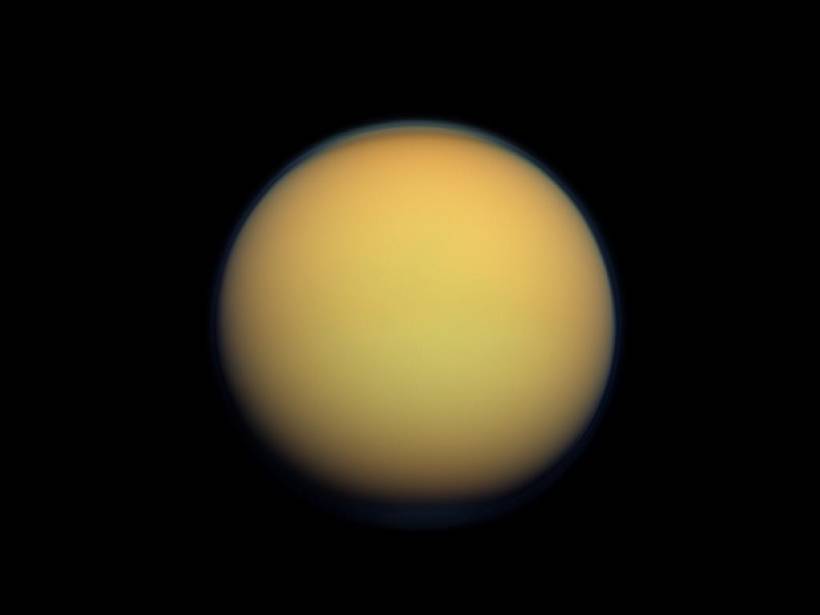It’s been 4 years since NASA’s Cassini spacecraft flew by Titan—the spacecraft vaporized in Saturn’s atmosphere in 2017—but the data collected on the 13-year mission are still yielding new information about Saturn’s largest moon. Researchers have long studied Cassini’s Titan flybys for hints of the moon’s climate and topography, but a new study bolsters our understanding of the moon’s day-to-day weather.
Over the years, Cassini has revealed Titan to be a relatively Earth-like planetary body. The moon’s climate cycles through seasons that last about 7.5 Earth years, and circulation in its atmosphere redistributes heat from the equator toward the poles, keeping temperatures relatively uniform and stable. On its surface, liquid natural gas flows through rivers and lakes. It’s the only place in the solar system other than Earth that experiences such a flow of liquids across its surface, and researchers have long theorized that these lakes and rivers are fed by rainfall from clouds of methane in the moon’s atmosphere.
“While rain may be predicted by theory, of course there are all kinds of theories,” said Roger Clark, a senior scientist at the Planetary Science Institute not involved in the new research. “One of the theories when we got to Titan was that it would be covered in an ocean of methane and that there wouldn’t be any solid surface, so theories may not have all of the data points.” But the new study is a “key data point in the case for active rain.”
“It’s the only extraterrestrial world where we can talk about extraterrestrial rainfall.”
“It’s the only extraterrestrial world where we can talk about extraterrestrial rainfall,” said Rajani Dhingra, a NASA postdoctoral fellow at the California Institute of Technology’s Jet Propulsion Laboratory and lead author on the new study.
A Bright Ephemeral Feature
The new study builds on previous studies from Dhingra and her colleagues in which the team combed through data from Cassini’s Visual and Infrared Mapping Spectrometer and spotted a massive reflective feature on the moon’s surface. The reflection, which the team deemed a bright ephemeral feature (BEF) in a 2019 paper, was temporary. The team theorized it was likely the result of sunlight reflecting off of a wet surface, akin to the way the Sun can reflect off wet pavement after rain here on Earth.
If the BEF was the result of a surface-wetting rainfall, that event would also have caused a local change in temperature. The logical next step for Dhingra and her colleagues was to look for that temperature change using Cassini’s Composite Infrared Spectrometer, which would provide further support for the idea that the reflective feature was the result of a surface-wetting rainfall event. But the data on the original BEF were too noisy to enable seeing any change in temperature. So in the new study, published in Geophysical Research Letters, the team identified another BEF in data from Cassini’s 121st flyby on 25 July 2016.
This time, the instruments collected enough spectra from both on and off the BEF to identify a temperature drop of roughly 1.2 kelvins within the BEF compared with the area around it.
“We were fortunate enough to have that number of spectra to see a perceptible temperature difference in a single flyby in a single day on Titan, so we have for the first time probably looked at the weather on Titan,” said Dhingra.
The team suspected that the temperature drop came from evaporative cooling and therefore would be temporary. Indeed, by the next flyby, the BEF was gone. “We don’t know the fate of the rainfall,” Dhingra said. Did it gather in a shallow puddle that quickly evaporated, seep into the ground, or drain into tributaries that flowed into lakes or seas elsewhere? Or did it never reach the surface at all, instead settling as a fog above the surface, to be blown away by the wind?

Clark noted that a wet surface, ice, or even clouds can all cause the kind of spectral reflections that have been detected on Titan.
Those questions will be much easier to answer when NASA’s Dragonfly mission reaches Titan. Dragonfly will launch in 2026 and land on Titan’s surface in 2034. Dhingra is eagerly awaiting its arrival, not least because Titan’s thick atmosphere makes studying rainfall or temperature changes at the surface very tricky from above.
“I’m awed that we can see something like that in a world that’s 10 times farther away from the Sun than Earth is, from a mission that was conceived in the 1980s,” Dhingra said. “I cannot wrap my head around the science we’re going to do with Dragonfly on the surface.”
—Kate Wheeling (@katewheeling), Science Writer
Citation:
Wheeling, K. (2021), A window into the weather on Titan, Eos, 102, https://doi.org/10.1029/2021EO156199. Published on 22 March 2021.
Text © 2021. The authors. CC BY-NC-ND 3.0
Except where otherwise noted, images are subject to copyright. Any reuse without express permission from the copyright owner is prohibited.

